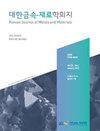Electrochemical Characteristics of Elastic, Non-Polar Polyurethane-Based Polymer Gel Electrolyte for Separator-Less Lithium-Ion Batteries
IF 1.4
4区 材料科学
Q4 MATERIALS SCIENCE, MULTIDISCIPLINARY
引用次数: 0
Abstract
Lithium-ion batteries (LIBs) have undergone countless enhancements in the past decade, mainly improvements in the basic components: electrodes, electrolyte, and separator. The separator, which acts as a physical barrier between the two electrodes, does not directly participate in the charge and energy storage.However, it is involved in the safety, form factor, and packaging density of the LIBs. While it occupies relatively less internal space than other components, the separator can be replaced with active materials such as gel polymer electrolytes (GPEs) which can serve as both the electrolyte and physical barrier between the electrodes. GPEs can potentially minimize the risks of liquid electrolytes, including flammability, electrolyte leakage, and explosion. Here we report the characteristics of polyurethane (PU)-based gel swollen in concentrated electrolyte solutions in separator-less cells. The poreless PU-based gel electrolyte conducts lithium ions, while preventing internal short-circuits. This is attributed to the presence of soft segments, which allow ion transport, and hard segments, which ensure mechanical integrity. Electrochemical measurements carried out in LFP half cells and symmetric Li cells revealed that the separator-less cells were operable between 0.2 C to 1 C rates, and that during long term cycling, the cells achieved stable Li electroplating overpotential, as the number of cycles increased.用于无隔膜锂离子电池的弹性非极性聚氨酯基聚合物凝胶电解质的电化学特性
在过去的十年里,锂离子电池(LIBs)经历了无数次的改进,主要是在基本组件方面的改进:电极、电解质和隔膜。隔膜作为两个电极之间的物理屏障,不直接参与电荷和能量存储。然而,它涉及LIBs的安全性、形状因子和封装密度。虽然它比其他部件占据相对较小的内部空间,但隔膜可以用活性材料代替,例如凝胶聚合物电解质(GPE),它可以用作电解质和电极之间的物理屏障。GPE可以潜在地将液体电解质的风险降至最低,包括易燃性、电解质泄漏和爆炸。本文报道了在无隔膜电池中,聚氨酯(PU)基凝胶在浓电解质溶液中溶胀的特性。无孔PU基凝胶电解质可传导锂离子,同时防止内部短路。这是由于存在允许离子传输的软段和确保机械完整性的硬段。在LFP半电池和对称Li电池中进行的电化学测量表明,无隔膜电池在0.2C至1C的速率之间可操作,并且在长期循环期间,随着循环次数的增加,电池实现了稳定的Li电镀过电位。
本文章由计算机程序翻译,如有差异,请以英文原文为准。
求助全文
约1分钟内获得全文
求助全文
来源期刊

Korean Journal of Metals and Materials
MATERIALS SCIENCE, MULTIDISCIPLINARY-METALLURGY & METALLURGICAL ENGINEERING
CiteScore
1.80
自引率
58.30%
发文量
100
审稿时长
4-8 weeks
期刊介绍:
The Korean Journal of Metals and Materials is a representative Korean-language journal of the Korean Institute of Metals and Materials (KIM); it publishes domestic and foreign academic papers related to metals and materials, in abroad range of fields from metals and materials to nano-materials, biomaterials, functional materials, energy materials, and new materials, and its official ISO designation is Korean J. Met. Mater.
 求助内容:
求助内容: 应助结果提醒方式:
应助结果提醒方式:


